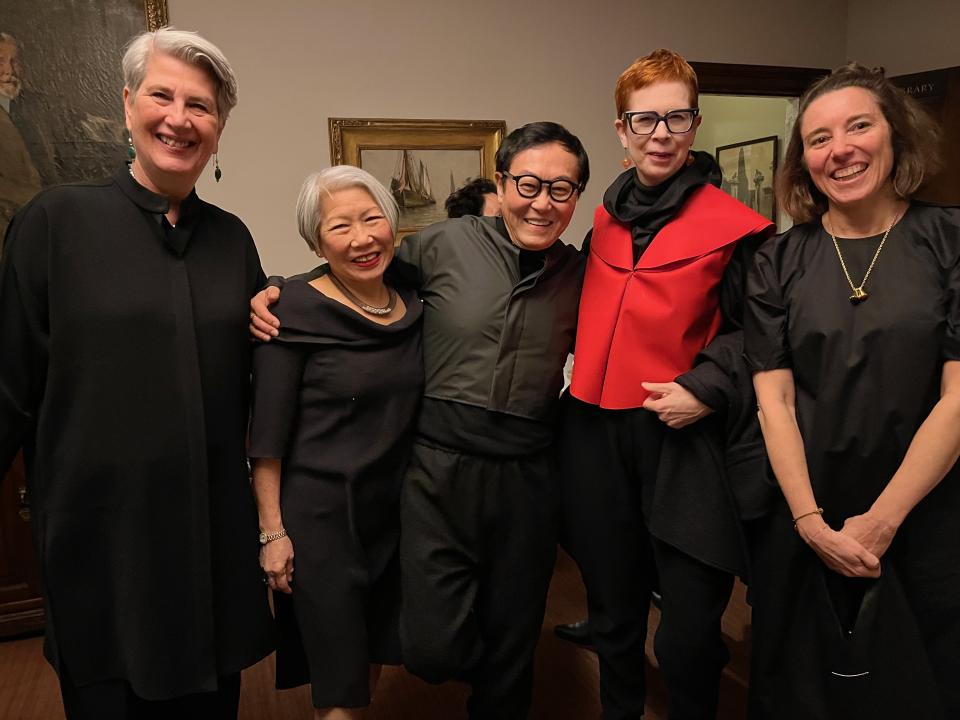Architects Celebrate Yeohlee’s Waste Not, Want Not Ethos

As a fashion designer known for her architectural sensibilities, it was fitting that Yeohlee Teng was celebrated Monday night by a group of her architect friends.
Teng recently redefined her career with plans to shutter her West 29th Street store, skip New York Fashion Week and take a good long trip to rejuvenate. On Monday, the longtime New Yorker was surrounded by well-wishers at The Century Association — a relic of a New York institution where the main activity is conversation. Many attendees turned up in creations made by the designer, who prefers to be called simply Yeohlee. The setting of the Renaissance Revival-style private club, which has 2,000-plus author and artist members and was once a favorite haunt for Mark Twain and literary fodder for Edith Wharton, was appropriate, too.
More from WWD
EXCLUSIVE: Chanel's First Watch and Jewelry Flagship in the U.S. Focuses on Craftsmanship
Charlene Prempeh on 'Now You See Me: 100 Years of Black Design'
Architects like Susan Chin, Tsao & McKown’s Calvin Tsao, Hana Kassem, Studio Joseph’s Wendy Evans Joseph, WXY Studio cofounder Claire Weisz, Andrea Woodner and Interboro Partners’ Georgeen Theodore turned up. Other civic-minded attendees included Fountain House’s Alexandra Herzan, the Municipal Arts Society’s Elizabeth Goldstein, the Van Alen Institute’s Deborah Marton, investor Mary Margaret Jones and The Noguchi Museum’s Amy Hau. Landscaper Ken Smith, Thames & Hudson’s Priscilla McGeehon, creative designer Matt Murphy, fashion designer Mary Ping and curator Harold Koda were there, too.

“I am interested in how people will dress in the future. [As for] the way that we dress now, what we consume, what we make and what we waste, those days are numbered. It is time to look for a new way of thinking,” Yeohlee said.
Asked by Marton about the use of recycled plastic in materials, the designer said she hadn’t given that much thought and is not very judgmental. “People do what they do. Who am I to say, ‘Blah, blah, blah?’” she said. “My personal feeling is that the way we have been manufacturing and the amount of clothes that we’ve been making is over. It’s like a clean slate — I’m done. I don’t need to do that anymore. There are a lot of people who are. I’m not going to contribute to that kind of waste.”
The United Nations’ Environment program has forecasted that if nothing changes, by 2050, the fashion industry will use up one quarter of the world’s carbon budget.
With the clash between fast fashion and sustainability only expected to intensify, Marton acknowledged how there are very different narratives routed in very different values. She praised John Galliano’s enchanting show last month in Paris, but said, “We have bigger fish to fry. Sure, it’s cool and the bodices were beautiful. But that’s not what’s important right now.”
Undeniably, fashion drives a certain type of capitalism that continually requires new purchases, Marton said, “That’s got to stop. Yeohlee’s your way of fashion is not driven by capitalist values. You’re saying, ‘This is about identity, form and durability.’”
Yeohlee said, “More than anything, it’s about use — u-s-e.”
Marton added, “If we don’t all think that, shame on us. The trick is to advance those values without feeling like it’s the apocolypse. Too often that is connected to this feeling that the world is ending. It’s not that. We need to move forward in a positive way and stop wasting things.”

Tsao, board chair of the American Academy in Rome, described Yeohleee “as the mastermind behind making all of us presentable. Now we have to think about what we have to do before praising a balloon-like garment bag that she created for a similarly shaped baseball jacket by sewing opposite curves.
“Architects are really fun to dress because they understand what your clothes and curves do,” she said.
Mention of Weisz’s design for The Spring Street Salt Shed, prompted Chau to say affirmatively, “Now that’s fashion, right?”
Many fashion designers have been using the futuristic buildings for photo shoots, the architect said. “It’s so refreshing to see a sculptural solution to a volume that could have been completely pedestrian. You guys made it beautiful — so thank you for that,” Murphy said.
Best of WWD


